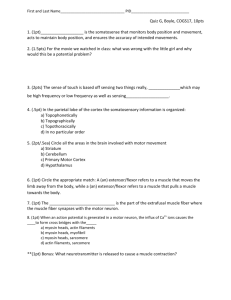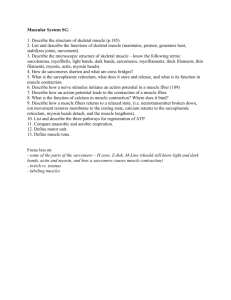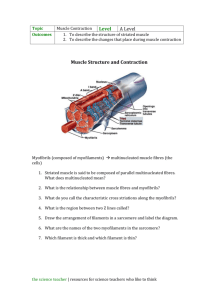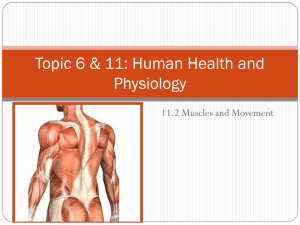Steps of a Muscle Contraction
advertisement
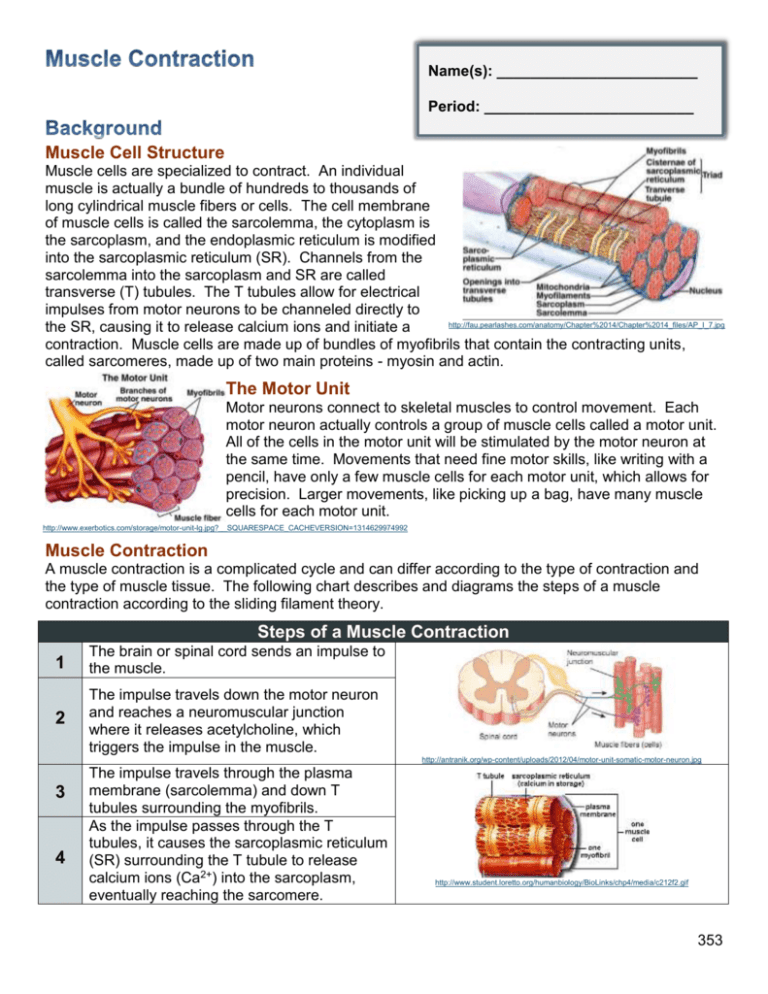
Name(s): ________________________ Period: _________________________ Muscle Cell Structure Muscle cells are specialized to contract. An individual muscle is actually a bundle of hundreds to thousands of long cylindrical muscle fibers or cells. The cell membrane of muscle cells is called the sarcolemma, the cytoplasm is the sarcoplasm, and the endoplasmic reticulum is modified into the sarcoplasmic reticulum (SR). Channels from the sarcolemma into the sarcoplasm and SR are called transverse (T) tubules. The T tubules allow for electrical impulses from motor neurons to be channeled directly to http://fau.pearlashes.com/anatomy/Chapter%2014/Chapter%2014_files/AP_I_7.jpg the SR, causing it to release calcium ions and initiate a contraction. Muscle cells are made up of bundles of myofibrils that contain the contracting units, called sarcomeres, made up of two main proteins - myosin and actin. The Motor Unit Motor neurons connect to skeletal muscles to control movement. Each motor neuron actually controls a group of muscle cells called a motor unit. All of the cells in the motor unit will be stimulated by the motor neuron at the same time. Movements that need fine motor skills, like writing with a pencil, have only a few muscle cells for each motor unit, which allows for precision. Larger movements, like picking up a bag, have many muscle cells for each motor unit. http://www.exerbotics.com/storage/motor-unit-lg.jpg?__SQUARESPACE_CACHEVERSION=1314629974992 Muscle Contraction A muscle contraction is a complicated cycle and can differ according to the type of contraction and the type of muscle tissue. The following chart describes and diagrams the steps of a muscle contraction according to the sliding filament theory. Steps of a Muscle Contraction 1 The brain or spinal cord sends an impulse to the muscle. 2 The impulse travels down the motor neuron and reaches a neuromuscular junction where it releases acetylcholine, which triggers the impulse in the muscle. http://antranik.org/wp-content/uploads/2012/04/motor-unit-somatic-motor-neuron.jpg 3 4 The impulse travels through the plasma membrane (sarcolemma) and down T tubules surrounding the myofibrils. As the impulse passes through the T tubules, it causes the sarcoplasmic reticulum (SR) surrounding the T tubule to release calcium ions (Ca2+) into the sarcoplasm, eventually reaching the sarcomere. http://www.student.loretto.org/humanbiology/BioLinks/chp4/media/c212f2.gif 353 5 6 7 8 9 The Ca2+ binds to troponin located on the actin filament, causing tropomyosin to move and expose binding sites for myosin. The myosin head now binds to actin and forms a crossbridge. ADP and Pi are released from myosin, which causes the myosin to move. This movement is called the power stroke. ATP binds to myosin causing it to release the actin and reverting ATP into ADP and Pi. The myosin is now ready to form another crossbridge and the cycle of contraction will continue until the impulse stops. Once the impulse stops, Ca2+ is released from troponin causing tropomyosin to cover the binding sites and prevent contraction. Ca2+ returns to the SR and waits for another impulse. This is relaxation. http://encyclopedia.lubopitko-bg.com/images/calcium%20and%20myosin%20in%20muscle%20contraction.jpg What is Happening When a Muscle Contracts? What is happening within the muscle cells and tissues when a muscle contracts is extremely complex. Animations can help us better understand this concept. Go to the following website: http://bcs.whfreeman.com/thelifewire/content/chp47/4702001.html Click on the animation tab at the top of the page. Choose the step-through version at the bottom of the animation. Answer the following questions as you watch the muscle contraction animation. Muscle Contraction Animation Question What are myofibrils? How are they organized into sarcomeres? What two protein filaments are found in the sarcomere? How are the Z line and titin part of the sarcomere? 354 Answer Muscle Cell Structure Draw a sarcomere and label the myosin, actin, Z-line, and titin. What is the sliding filament theory? Steps of a Muscle Contraction Step 1 What triggers a contraction? Step 2 What neurotransmitter is released at a neuromuscular junction? Step 3 Where does the electrical signal propagate or travel? Step 4 What is released from the sarcoplasmic reticulum as the action potential passes through the T tubules? Step 5 Where does the calcium travel? What two proteins are found on actin filaments? Step 6 What is bound to the myosin heads? Step 7 What happens when calcium binds to troponin? 355 Step 8 Onto what does the myosin head bind to? What is formed? Step 9 What happens to Pi and ADP when myosin binds? Step 10 What is the power stroke? Step 11 What happens when ATP binds to the myosin head? Step 12 What happens after the action potential ceases? Return to the animation page and watch the narrated version to link all of the steps together. 356 Review Questions – USE COMPLETE SENTENCES!!!! 1. Describe the organization of a muscle. 2. What is the sarcolemma? 3. What is the sarcoplasm? 4. What is the sarcoplasmic reticulum? 5. What are T tubules? 6. What are myofibrils? 7. What proteins make up the sarcomere? 8. What is the motor unit? 9. How are motor units different in muscles that need fine motor movement compared to those that require larger movements? 10. Describe or draw and label the 9 steps of a muscle contraction according to the sliding filament theory. 11. What is the purpose of calcium in a muscle contraction? 12. What is the power stroke? 13. What causes the muscle cell to relax? 357




